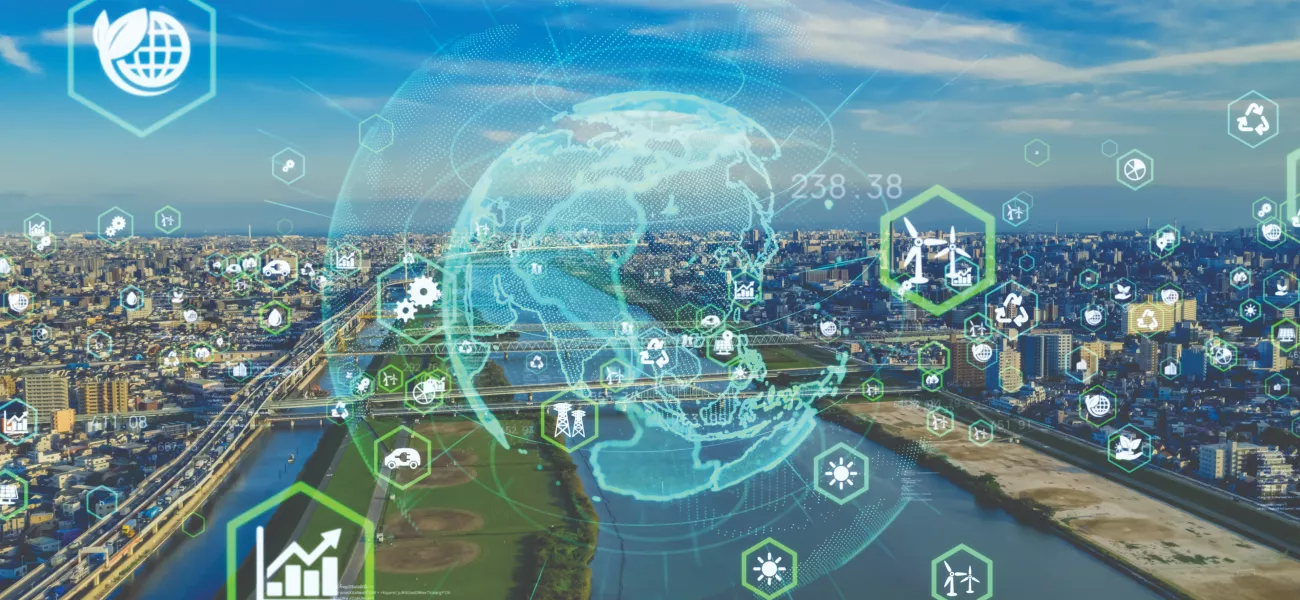
Sustainability is an objective high on everyone’s agenda. In every nation across the globe, we all have a responsibility and role to play in building a more sustainable future.
Cities have a disproportionate impact on the environment. As major economic drivers producing over 80% of the world’s GDP, they also produce more than 70% of global greenhouse gas emissions despite only covering 2% of the world’s surface. They therefore have a large role to play in meeting sustainability objectives. We have for a long time seen an increasing trend in urbanization. An estimated seven in ten people will be living in urban areas by 2050. These factors bring ever growing challenges to the work towards sustainability.
City authorities face a number of regulations, policies and expectations from both organizations and citizens. The pandemic affected the way people want to live and what they value. Cleanliness, open spaces and green areas have disrupted the traditional city planning.
But while the challenges are significant, there’s evidence that city authorities are taking their responsibility seriously.
The UN Sustainability Development Goals: a framework for cities
An important framework for cities large and small has been provided by the United Nations Sustainable Development Goals (SDGs). Created in 2015 and designed to be achieved by 2030, the SDGs are 17 interlinked global goals designed to be a “blueprint to achieve a better and more sustainable future for all”.
The adoption of the SDGs by the world’s cities is in no doubt. Recent research, which benchmarked 200 cities across the globe to determine their future readiness, showed that key SDG indicators ranked high on the list of priorities for cities. 67% of cities wanted to improve citizen safety through urban planning, the same percentage also wanted to incorporate sustainability metrics into local planning processes, and two thirds (59%) also wanted to incorporate environmental metrics into investment decisions.
From video surveillance to actionable data

Video surveillance has played a central role in the liveability of cities for many years of course, particularly in keeping citizens safe and secure. The increasing sophistication of video surveillance technology – particularly related to video analytics and the ability to link data from sensors of multiple types, including video cameras – means that it can support a number of the challenges facing cities and specifically the SDGs smart cities are looking to accomplish.
Three of the fundamental areas that cities are focused on, and which directly relate to a number of SDGs are the environment, mobility and public safety. And far from being independent of each other, these factors are very much interlinked. Again, this reinforces the critical need to break down silos and enable data sharing across the city and, as stated in SDG 17, partnerships are the main enabler of success in sustainability targets.
The environment as a measure of sustainability
Monitoring of environmental factors is essential in smart city sustainability and ensuring the health and well-being of citizens. Part of the strength of the SDGs is the level of detail defined within them.
Take for instance one part of Goal 11, Target 11.6, which sets the objective: “By 2030, reduce the adverse per capita environmental impact of cities, including by paying special attention to air quality and municipal and other waste management”.
The detail does not stop there. Indicators related to this target are specified as the proportion of total municipal waste collected and managed in controlled facilities, and the annual mean levels of fine particulate matter in the air of cities. It’s this level of evaluation which will result in achievement of the goals making a real difference, and the use of technology is central to this.

Poor air quality (and also noise pollution) is closely linked to serious health issues. Highly sensitive environmental sensors – such as those measuring air quality – used alongside video surveillance can give city authorities early warning of issues, visual verification, enabling them to take appropriate action.
Over time, data can be analyzed and used to plan longer-term initiatives to reduce the impact of pollution and noise, as well as being the foundation for open and transparent communication with a city’s citizens. Video surveillance can monitor waste collection to ensure collection in accordance with the SDGs, as well as watch for and deter illegal dumping (including disposal of waste into the oceans, as covered by Target 14.1), vandalism and even littering, all of which have a negative impact on a city’s environment.
The SDGs are, in part, a reaction to the environmental damage that has taken place over recent centuries of the industrial age one result of which is, of course, climate change. The world as a whole is experiencing severe weather conditions on a more frequent basis, which have the potential to disrupt urban infrastructure, the provision of critical services and with that risk harm to citizens. Again, the SDGs focus specifically on this through Target 11.5: “Reduce the adverse effects of natural disasters” with indicators related to the loss of human life and disruption to critical infrastructure.
Axis cameras and Internet of Things sensors can be used to implement early flooding detection and warning systems in cities to give authorities the time to prepare for severe weather. Officials can be alerted as soon as systems detect that a threshold has been breached, allowing for connected technology to relay live and pre-recorded messages and instructions to aid in evacuation efforts or re-routing traffic. In the aftermath of natural disasters, video surveillance can also be of great help with rescue and relief operations, with the data collected in the long-term being used to inform flood defence planning. In addition to monitoring for polluters and natural disasters, Axis sensors can aid a city’s push towards sustainability through adaptive lighting. LED streetlights with sensors attached can allow operators to adjust the lighting according to weather conditions such as fog, rain etc., as well as the natural lighting conditions, so streetlights only use power when needed and can, therefore, lower the energy emissions for the city and the costs of running public lighting.
Sustainable mobility and transportation

Enabling citizens to move around freely and easily is also a fundamental part of a city’s liveability and is covered by Target 11.2 in the SDGs through: “Affordable and sustainable public transport systems”. It is critical that transportation within cities has as minimal negative impact on the environment as possible (and directly relates to our earlier points around air quality and noise pollution).
Video surveillance helps ensure the safety of citizens and personnel on public transportation, and also monitors road traffic, alerting operators to incidents which can cause traffic – and therefore pollution – to quickly build up. Within SDG 3, “Good Health and Well-Being”, a specific Target relates to the reduction of road injuries and deaths. Again, video surveillance utilizing traffic incident analytics is of huge benefit in the effective and safe management of urban traffic, whether public or private.
Increasingly, data from environmental sensors and video surveillance cameras is being used as a proactive tool in planning and managing transportation infrastructure to reduce its environmental impact. Data from video surveillance can also be used to assist citizen mobility, for instance directing drivers quickly and efficiently to available parking spots or electric vehicle recharging stations.
Public safety in cities
“Making people feel safe” is a goal for every city and is covered in part in the SDGs under Target 11.7: “Provide access to safe and inclusive green and public spaces”. It’s also one of the fundamental roles that video surveillance plays across the whole city.
It remains a sad truth that the density of population in urban centres means that they are places that can both attract criminal activity, and where incidents and emergencies can quickly become a serious risk to large numbers of people. SDG 16, “Peace, Justice and Strong Institutions”, covers a number of relevant areas in detail, with specific targets focused on reducing violence and combating organized crime.
While these are perhaps seen as a more ‘traditional’ place where video surveillance in used, the advances in technology mean that its support is increasingly intelligent, accurate and allows for greater proactivity, rather than simply post-incident investigation.

Rather than rely purely on manual monitoring, increasingly intelligent video analytics can monitor multiple video streams, spotting anomalies, unusual patterns, specific objects or suspicious behavior and quickly bring an operator’s attention to the scene. Intervention can then be triggered through emergency services, or via audio speakers on site, either warning criminals that they’re being watched, or offering assistance, advice and guidance to people at the scene.
Such rapid reaction can stop a crime before it is committed, prevent the escalation of an incident, evacuate a specific area or provide direct assistance before emergency services arrives.
The SDGs move beyond crime prevention, however, with further opportunities for video surveillance to play a role. Again, within SDG 16 – which talks of “strong institutions”, Target 16.3 measures the promotion of the rule of law and ensuring equal access to justice for all. Ensuring the authenticity and allowing the use of evidence from video surveillance and body worn cameras is central to a fair and equal justice system.
Continually exploring opportunities to support sustainability
While these are just a few examples of where video surveillance and other sensors can directly support the achievement of the SDGs, along with the research undertaken by ESI ThoughtLab, it’s clear that technology and data are central to success.
Almost every decision a city authority makes should be seen through the lens of its contribution towards (or against) SDGs. These latest commitments from city authorities and innovations in technology – including from Axis and its partners – give us cause for optimism.
